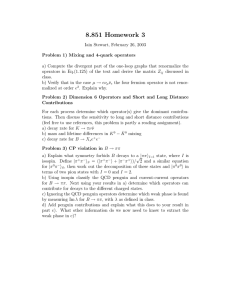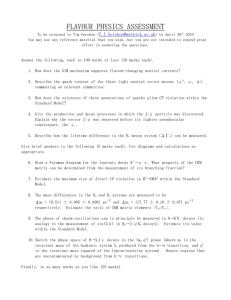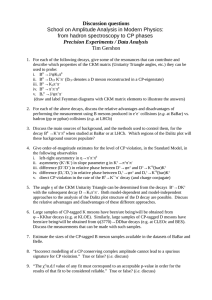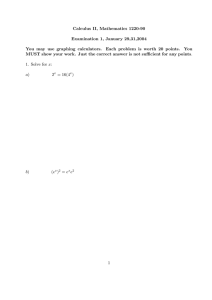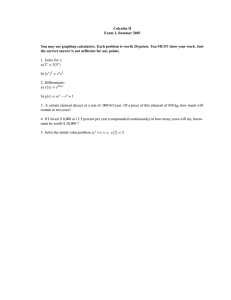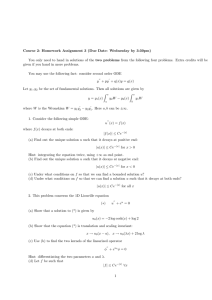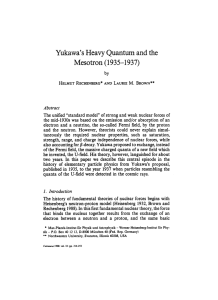Document 13650521
advertisement
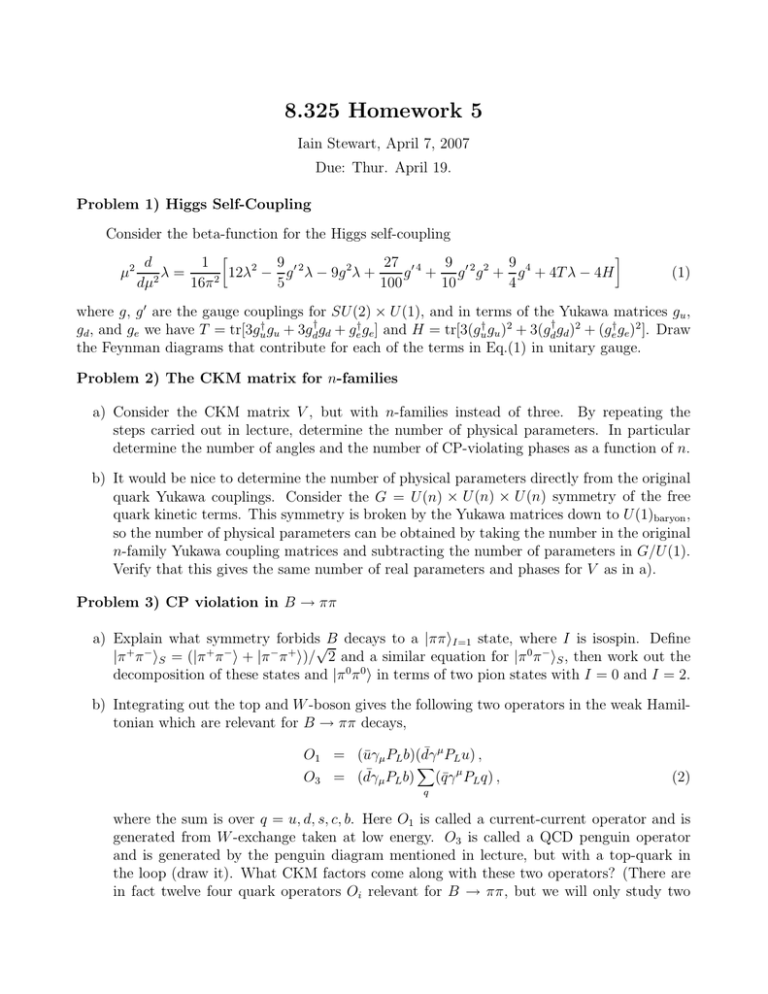
8.325 Homework 5 Iain Stewart, April 7, 2007 Due: Thur. April 19. Problem 1) Higgs Self-Coupling Consider the beta-function for the Higgs self-coupling d 1 9 27 ′ 4 9 9 λ= 12λ2 − g ′ 2 λ − 9g 2λ + g + g ′ 2 g 2 + g 4 + 4T λ − 4H µ 2 2 dµ 16π 5 100 10 4 2 � � (1) where g, g ′ are the gauge couplings for SU(2) × U(1), and in terms of the Yukawa matrices gu , gd , and ge we have T = tr[3gu† gu + 3gd† gd + ge† ge ] and H = tr[3(gu† gu )2 + 3(gd† gd )2 + (ge† ge )2 ]. Draw the Feynman diagrams that contribute for each of the terms in Eq.(1) in unitary gauge. Problem 2) The CKM matrix for n-families a) Consider the CKM matrix V , but with n-families instead of three. By repeating the steps carried out in lecture, determine the number of physical parameters. In particular determine the number of angles and the number of CP-violating phases as a function of n. b) It would be nice to determine the number of physical parameters directly from the original quark Yukawa couplings. Consider the G = U(n) × U(n) × U(n) symmetry of the free quark kinetic terms. This symmetry is broken by the Yukawa matrices down to U(1)baryon , so the number of physical parameters can be obtained by taking the number in the original n-family Yukawa coupling matrices and subtracting the number of parameters in G/U(1). Verify that this gives the same number of real parameters and phases for V as in a). Problem 3) CP violation in B → ππ a) Explain what symmetry forbids√B decays to a |ππiI=1 state, where I is isospin. Define |π + π − iS = (|π + π − i + |π − π + i)/ 2 and a similar equation for |π 0 π − iS , then work out the decomposition of these states and |π 0 π 0 i in terms of two pion states with I = 0 and I = 2. b) Integrating out the top and W -boson gives the following two operators in the weak Hamil­ tonian which are relevant for B → ππ decays, ¯ µ PL u) , O1 = (ūγµ PL b)(dγ � ¯ µ PL b) (q̄γ µ PL q) , O3 = (dγ (2) q where the sum is over q = u, d, s, c, b. Here O1 is called a current-current operator and is generated from W -exchange taken at low energy. O3 is called a QCD penguin operator and is generated by the penguin diagram mentioned in lecture, but with a top-quark in the loop (draw it). What CKM factors come along with these two operators? (There are in fact twelve four quark operators Oi relevant for B → ππ, but we will only study two of them in this problem.) A single insertion of O1 or O3 mediates the B → ππ transition. Use isospin and classify O1 and O3 . Next use your results in a) and determine which operators contribute for decays to the different charged pion final states. How many strong interaction parameters does isospin allow for these decays? c) Ignoring the QCD penguin operator, determine which weak phase of the unitary triangle is found by measuring Im λ from the time-dependent asymmetry in B → π + π − decays. The parameter λ was defined in lecture in our discussion of CP-violation in interference with and without mixing. d) Add the penguin contribution and explain what this does to your result in part c). What non-CKM information do we now need to know to extract information about weak phases from Im λ? [Aside: In fact, if we had precise measurements of branching ratios and CPasymmetries for the different charge channels in b) then it can be shown that this would allow us to simultaneously determine the strong interaction parameters and the phase you found in c).]
